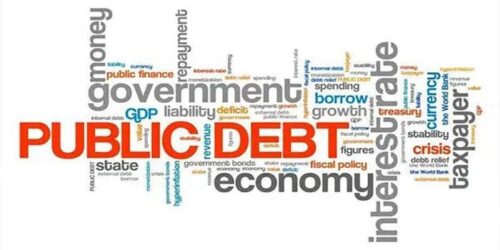Pakistan’s total public debt has gone up by Rs 14.9 trillion during the current government as it increased sharply from Rs24.953 trillion by the end of FY2018 to Rs39.859 trillion till June 30, 2021.
“The total public debt has gone up by Rs3.46 trillion in the last fiscal year as it went up from Rs36.399 trillion in June 2020 to Rs39.859 trillion till end-June 2021. The federal primary deficit (surplus) Rs 967 billion, interest payment of Rs2,750 billion and depreciation of exchange rate (rupee against US dollar) contributed Rs 665 billion to the rising total public debt burden in FY2021” the Annual Debt Review and Public Debt Bulletin FY 2020-21 prepared by the Finance Ministry’s Debt Management Wing stated on Tuesday.
The Fiscal Responsibility and Debt Limitation (FRDL) Act 2005 defines “total public debt” as debt owed by the government (including federal and provincial governments) serviced out of consolidated funds and debts owed to the International Monetary Fund. However, it does not include total liabilities. The total public debt and liabilities stood at Rs29.8 trillion by the end of FY2018, which jumped up to Rs47.8 trillion till September 2021, so it surged by Rs18 trillion under dispensation of the current government.
During the PMLN rule from 2013 to 2018, the total public debt and liabilities had increased from Rs14 trillion to Rs29 trillion, so in five years, it increased by almost Rs15 trillion. Under the PPP government, the total public debt and liabilities had gone up from Rs6 trillion to Rs14 trillion from 2008 to 2013 and it surged by Rs8 trillion. But the PTI ballooned public debt and liabilities at the supersonic speed and it increased by Rs18 trillion just in three years.
“This perpetual surge in debt burden shows that the total public debt and liabilities are rising at the supersonic speed and heading towards a complete disastrous situation,” an independent economist stated.
The domestic debt stood at Rs 26.265 trillion and external debt at Rs13.594 trillion till end-June 2021. The total public debt in US dollars stood at $253 billion by using an exchange rate of Rs157.3 against US dollar. Now the exchange rate has nosedived and stood at Rs173 against US dollar. Of the total public debt, the share of domestic debt stands at 66 per cent while the foreign debt is hovering around 34 per cent. Out of total public debt, the share of rupee component stands at 66 per cent, US dollar 18 per cent, Special Drawing Rights (SDR) of the IMF 11 per cent, Japanese Yen 2 per cent and other currencies 3 per cent. The total domestic debt stood at Rs26.265 trillion out of which the permanent debt is hovering at Rs15.911 trillion, floating debt Rs6.68 trillion and unfunded debt Rs 3.764 trillion.
The total external debt was recorded at $86.4 billion at end-June 2021 as the government external debt was standing at $79.031 billion and the debt from the IMF $7.384 billion. Pakistan’s external debt is derived from four key sources, with around 48 per cent coming from multilateral loans, 30 per cent from bilateral loans, 13 per cent from commercial loans and 9 per cent from Eurobonds/Sukuk at end-June 2021. Although borrowing from commercial sources has relatively increased during the last few years, multilateral and bilateral sources still cumulatively constitute 78 per cent of external public debt portfolio as of end-June 2021.
The official report on Public Debt stated that the government remained within the fixed benchmarks of risk indicators during the fiscal year 2020-21. However, few annual targets set for 2020-21 with respect to debt risk indicators were slightly missed mainly due to the following reasons including higher than envisaged federal fiscal deficit; lower than planned issuance of Sukuks due to unavailability of assets; net retirement in NSS stock mainly due to encashment of prize bonds; non-materialization of envisaged privatisation proceeds; running-off of existing external public debt portfolio and slightly higher mobilization from commercial sources (foreign commercial banks/ Eurobonds); and the need to build the cash-buffer in anticipation of upcoming maturities.
The total guaranteed stock stood at $12.3 billion in June 2019 and climbed to $15.3 billion till end-June 2021. The power sector remained the largest beneficiary of government guarantees stock as out of total $15.3 billion stocks, the power sector guarantees stood at $12.7 billion, aviation $1.3 billion, financial $0.4 billion, manufacturing $0.3 billion, oil and gas $0.3 billion and others $0.2 billion.






